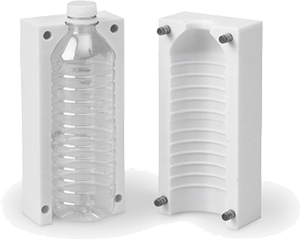Overview
Ditch traditional machining costs associated with design changes. Blow molding is a fast and economical manufacturing process that produces prototypes made of hollow plastic parts such as bottles and containers- ideal for testing and validation in final production plastics.

Process
The blow molding process uses many common plastic materials including polystyrene, polycarbonate, polyvinylchloride, and resins including polyethylene. These can be easily replaced by Polyjet or FDM 3D printing materials to create a functional prototype, aiding the production process. Manufacturers use these prototypes to visualize and analyze measurements of a molded product prior to mass production. Using Polyjet & FDM technologies, the results are models with improved surface quality, durability, build speed, and cost-efficiency, making blow-mold prototyping ideal as all three blow-molding methods can be applied. There are three major variations of blow molding:
Extrusion Blow Molding (EBM)
An extruder drops a parison (hot, hollow tube of plastic) between two mold halves. One end of the gap is sealed while the other end is left open. Air is injected through the open end, forcing the malleable plastic against the mold walls. Upon cooling, the plastic retains the contour of the mold. This process can produce very large containers but is not suitable for all materials.
Injection Blow Molding (IBM)
This two-step process begins with injection molding a preform, which is then heated, placed in a blow mold and inflated. Compared to EBM, this process allows for more careful control over part walls and results in better transparency and surface quality.
Injection Stretch Blow Molding (ISBM)
This method incorporates an additional step where the injection–molded preform is heated, then mechanically stretched before inflation. This contributes to the part’s strength and wall uniformity.
Application
Patterns 3D printed with PolyJet or FDM are a best fit for blow molding when:
- Production levels are low to moderate or custom
- Multiple designs must be considered
- Prototypes are required from the final plastic material
- Design changes are likely
Benefits of PolyJet and FDM tools for blow molding include:
- Lead time reduced by 30 to 70 percent
- Prototype mold cost reduced by 40 to 80 percent
- Stability, eliminating distortion with heat
- Durability through hundreds of cycles
- Little or no need for post processing
Steps
-
Designing the Tool
- Design with additive manufacturing in mind. Assure vent areas relieve extreme pressure and temperatures while maintaining durability to function. Metal plates should also be inserted on top to absorb the impact of the blowing pin against the mold
-
Printing the Tool
- Print your tool with either Polyjet or FDM 3D printers with the correct build orientation and parameters
-
Post Processing
- Perform secondary